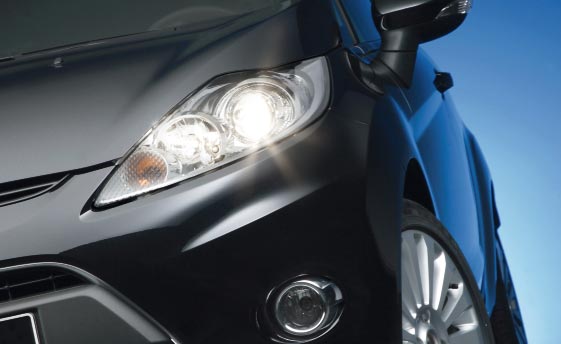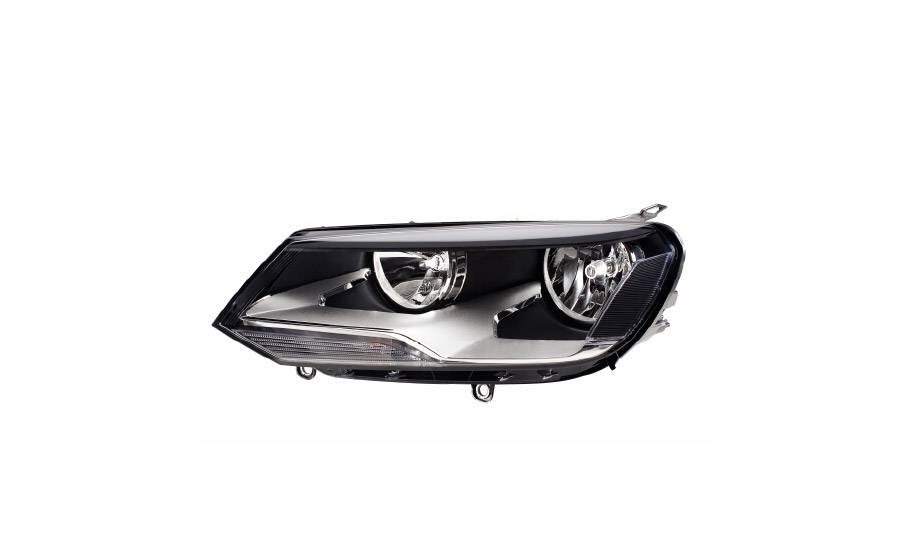Headlights
The primary task of headlights on cars is to illuminate the roadway and facilitate fatigue-free and safe driving. Headlights and their light sources are thus vehicle components that are relevant to safety...
Function
 The primary task of headlights on cars is to illuminate the roadway and facilitate fatigue-free and safe driving. Headlights and their light sources are thus vehicle components that are relevant to safety. They require official approval and must not be tampered with. The nature and location of light functions on a vehicle and their design, light sources, colours and photometric values are regulated by law.
The primary task of headlights on cars is to illuminate the roadway and facilitate fatigue-free and safe driving. Headlights and their light sources are thus vehicle components that are relevant to safety. They require official approval and must not be tampered with. The nature and location of light functions on a vehicle and their design, light sources, colours and photometric values are regulated by law.
Headlight systems
Today's cars feature the following headlight systems: Halogen headlights Headlights with H3, HB3, H7 and H9 bulbs have traditionally been used in vehicle illumination. They still enjoy great popularity today. Advances in halogen technology have resulted in a very good price/performance ratio for halogen headlights as original equipment. Xenon headlights Xenon light has two decisive advantages over the light emitted by conventional halogen bulbs:
- Firstly, a Xenon bulb supplies more than twice the light of a modern H7 bulb but needs only 2/3 of the electrical power to do this.>
- Secondly, the light colour of a Xenon bulb is similar to daylight. This additional light makes the road lighter and brighter.
 Dangers at the edge of the road and even on the road are detected sooner. The improved illumination of the road and the daylight quality of the Xenon light accommodate the natural viewing habits of the human eye – drivers do not get tired as quickly and adopt a more relaxed driving style.
With Xenon technology, instead of the coiled filament in a conventional bulb, the light in the bulb is generated by an intensive light arc. The high voltage of 20,000 V required to light up the Xenon bulb is supplied by an electronic ballast.
Full LED headlights
Energy-efficient and cost-effective, LEDs (light-emitting diodes) are becoming increasingly popular in all areas of the vehicle industry. Leading component manufacturers have succeeded in expanding the spectrum of possible applications for vehicles of all types at a rapid pace. Reliability, cost-effectiveness and design variety are the convincing arguments in favour of using LEDs in common applications.
Dangers at the edge of the road and even on the road are detected sooner. The improved illumination of the road and the daylight quality of the Xenon light accommodate the natural viewing habits of the human eye – drivers do not get tired as quickly and adopt a more relaxed driving style.
With Xenon technology, instead of the coiled filament in a conventional bulb, the light in the bulb is generated by an intensive light arc. The high voltage of 20,000 V required to light up the Xenon bulb is supplied by an electronic ballast.
Full LED headlights
Energy-efficient and cost-effective, LEDs (light-emitting diodes) are becoming increasingly popular in all areas of the vehicle industry. Leading component manufacturers have succeeded in expanding the spectrum of possible applications for vehicles of all types at a rapid pace. Reliability, cost-effectiveness and design variety are the convincing arguments in favour of using LEDs in common applications.
Safety
At dark and cold times of the year when bad weather (rain, fog, storms) is commonplace, it is important to be able to see and be seen. For drivers, this means being well lit! Good light is essential to be able to see hazards in traffic in good time and thus react appropriately to aquaplaning, skid hazards or obstructions on the road. It is equally important in order to be able to detect pedestrians, cyclists and other road users in good time. Unfortunately, good light and therefore safety cannot always be taken for granted. The latest studies show that an average of 35% of drivers on the road do not have sufficient lighting, thereby creating safety risks for themselves and others. "See and be seen" is the mantra of every foresighted, responsible driver.
Depreciation
Thanks to long-life LED technology, frequent bulb changes are a thing of the past. Comparative analyses show that the use of LED technology compared with conventional bulbs usually pays off after the first bulb change. There are no ongoing costs due to replacing faulty lamps or bulbs. As LED lights are wear-free and maintenance-free, they are a significant contributing factor to a vehicle's ability to maintain its value.
Environmental protection
The increasing use of LEDs in headlights and tail lamps is set to continue. Already today we are seeing both headlights and tail lamps that rely solely on LEDs for their light source. If we consider the extremely long service life of LEDs, and the fact that they are maintenance-free, there is simply no doubt - where impact on the environment is concerned, LED lighting technology cannot be recommended highly enough.










